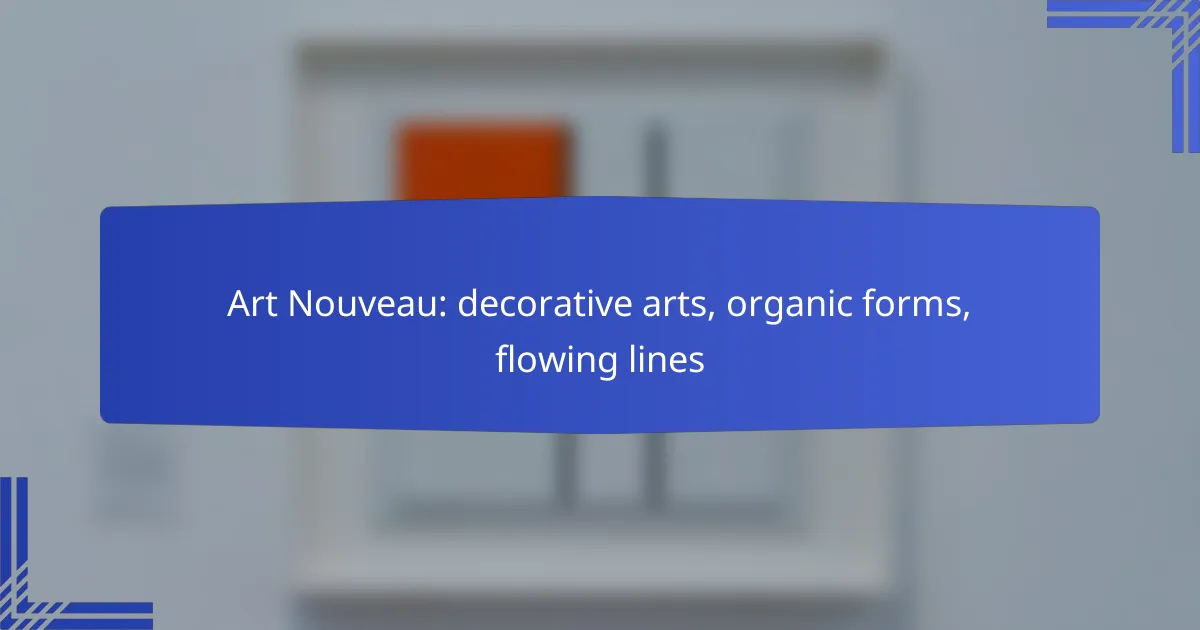Art Nouveau emerged as a transformative movement in the decorative arts during the late 19th and early 20th centuries, celebrated for its emphasis on organic forms and flowing lines. This style sought to harmonize art with nature, resulting in innovative designs that spanned furniture, textiles, and architecture. Notable artists like Alphonse Mucha and Antoni Gaudí exemplified this aesthetic, blending functionality with artistic expression to create visually captivating works.

How does Art Nouveau influence decorative arts in the UK?
Art Nouveau significantly shaped decorative arts in the UK by emphasizing organic forms and flowing lines, creating a distinctive aesthetic that merged functionality with artistic expression. This movement inspired a wide range of decorative items, from furniture to textiles, reflecting a harmonious relationship between nature and design.
Impact on furniture design
Art Nouveau furniture design is characterized by its sinuous lines and natural motifs, often incorporating materials like wood, metal, and glass. Designers such as Charles Rennie Mackintosh and Edward William Godwin embraced these principles, creating pieces that were both functional and visually striking.
Common features include curved shapes, floral inlays, and intricate carvings, which contribute to a sense of elegance. When selecting Art Nouveau furniture, consider the balance between aesthetics and comfort to ensure a harmonious living space.
Integration in architecture
Art Nouveau’s influence on architecture in the UK is evident in the use of organic forms and elaborate decorative elements. Buildings often feature flowing lines, asymmetrical shapes, and nature-inspired motifs, creating a seamless blend between structure and environment.
Notable examples include the Glasgow School of Art and the iconic Liberty department store in London. When exploring Art Nouveau architecture, pay attention to the details, such as wrought ironwork and stained glass, which enhance the overall design.
Use in textiles
Textiles in the Art Nouveau style showcase intricate patterns and natural themes, often using rich colors and luxurious materials. Fabrics were designed to complement the flowing lines of furniture and architecture, creating a cohesive aesthetic throughout a space.
Designers like William Morris played a crucial role in this movement, producing wallpapers and fabrics that featured botanical motifs. When choosing Art Nouveau textiles, look for designs that reflect the organic forms characteristic of the style to maintain visual harmony.
Influence on ceramics
Art Nouveau ceramics are distinguished by their organic shapes and decorative glazes, often inspired by nature. Potters and ceramicists embraced the movement’s principles, creating pieces that were both functional and artistic.
Examples include the works of the Royal Worcester and Minton, which featured flowing lines and floral designs. When selecting Art Nouveau ceramics, consider the craftsmanship and unique characteristics that make each piece a work of art.
Role in glasswork
Glasswork during the Art Nouveau period showcased innovative techniques and designs, with a focus on fluid forms and natural motifs. Artists like Louis Comfort Tiffany and René Lalique pioneered the use of colored glass and intricate patterns, elevating glass to a fine art form.
Common techniques included cameo glass and iridescent finishes, which added depth and visual interest. When incorporating Art Nouveau glasswork into your decor, choose pieces that highlight the movement’s signature style to enhance the overall ambiance of your space.

What are the key characteristics of Art Nouveau?
Art Nouveau is characterized by its emphasis on organic forms, flowing lines, and nature-inspired motifs. This decorative arts movement, popular in the late 19th and early 20th centuries, sought to create harmony between art and nature through innovative design and new materials.
Organic forms
Organic forms in Art Nouveau are inspired by natural shapes and structures, often resembling plants, flowers, and other elements of the natural world. These forms are typically asymmetrical and fluid, breaking away from rigid geometric shapes found in previous artistic styles.
Designers used organic forms to create a sense of movement and life in their work, resulting in pieces that feel dynamic and engaging. Furniture, architecture, and decorative objects often feature curves and shapes that mimic the organic growth patterns seen in nature.
Flowing lines
Flowing lines are a hallmark of Art Nouveau, emphasizing elegance and continuity. These lines often weave through designs, creating a sense of rhythm and connection between different elements. The use of curvilinear forms helps to soften the overall aesthetic, making it more inviting.
In practice, flowing lines can be found in everything from the architecture of buildings to the intricate details of jewelry. They contribute to a cohesive look that draws the viewer’s eye and enhances the overall experience of the artwork.
Nature-inspired motifs
Nature-inspired motifs are central to Art Nouveau, with artists frequently incorporating floral, faunal, and botanical themes into their work. Common examples include stylized flowers, leaves, and vines that reflect the beauty of the natural environment.
These motifs not only serve decorative purposes but also symbolize the interconnectedness of life and art. By using nature as a source of inspiration, artists aimed to elevate everyday objects into works of art that resonate with the viewer’s appreciation for the natural world.
Use of new materials
The use of new materials was a significant aspect of Art Nouveau, as artists and designers experimented with innovative substances to enhance their creations. Materials such as wrought iron, glass, and ceramics were frequently employed to achieve unique textures and finishes.
This experimentation allowed for greater flexibility in design, enabling the creation of intricate patterns and forms that were previously difficult to achieve. The combination of traditional craftsmanship with modern materials resulted in distinctive pieces that remain highly valued today.

Which notable artists and designers exemplify Art Nouveau?
Art Nouveau is characterized by its decorative arts and organic forms, with several artists and designers standing out for their contributions. Notable figures include Alphonse Mucha, Gustav Klimt, Antoni Gaudí, and Louis Comfort Tiffany, each bringing unique interpretations of flowing lines and nature-inspired motifs.
Alphonse Mucha
Alphonse Mucha is renowned for his posters and illustrations that epitomize the Art Nouveau style. His work often features elegant women surrounded by intricate floral patterns, showcasing flowing lines and harmonious colors.
Much’s most famous series, “The Seasons,” highlights the beauty of nature through graceful figures and elaborate backgrounds. His designs not only influenced graphic arts but also extended to furniture, textiles, and jewelry.
Gustav Klimt
Gustav Klimt is celebrated for his distinctive paintings that blend symbolism and decorative arts within the Art Nouveau movement. His use of gold leaf and intricate patterns creates a luxurious aesthetic, evident in works like “The Kiss.”
Klimt’s art often explores themes of love, femininity, and sensuality, using flowing lines and organic forms to evoke emotion. His approach has left a lasting impact on modern art and design.
Antoni Gaudí
Antoni Gaudí is best known for his architectural masterpieces that embody the principles of Art Nouveau. His buildings, such as the Sagrada Família and Park Güell, feature organic shapes, vibrant colors, and intricate tile work.
Gaudí’s designs often mimic natural forms, integrating structures with their surroundings. His innovative use of materials and forms challenges traditional architectural norms, making his work a significant part of Catalonia’s cultural heritage.
Louis Comfort Tiffany
Louis Comfort Tiffany is a key figure in the decorative arts, particularly known for his stained glass work. His creations often incorporate floral and organic motifs, showcasing the flowing lines typical of Art Nouveau.
Tiffany’s lamps and windows feature vibrant colors and intricate designs, making them highly sought after. His emphasis on craftsmanship and artistic expression has influenced generations of artisans in the decorative arts field.

How can one identify Art Nouveau pieces?
Art Nouveau pieces can be identified by their distinctive organic forms, flowing lines, and intricate decorative elements. This style emerged in the late 19th and early 20th centuries, characterized by a harmonious blend of art and craftsmanship.
Recognizing stylistic elements
Art Nouveau is known for its use of sinuous curves and natural motifs, often inspired by plant life and the human figure. Look for asymmetrical designs, ornate patterns, and an emphasis on craftsmanship in materials like glass, metal, and ceramics. Common motifs include flowers, vines, and flowing hair, which contribute to the overall fluidity of the pieces.
Furniture, jewelry, and architecture from this period often feature these stylistic elements, making them easily recognizable. For example, the works of designers like Alphonse Mucha and Antoni Gaudí exemplify the movement’s aesthetic through their elaborate and cohesive designs.
Understanding historical context
Art Nouveau emerged as a reaction against the industrialization of the late 19th century, promoting a return to handcrafted artistry. This movement was prevalent in various countries, including France, Belgium, and Austria, each contributing unique interpretations. In France, it was known as “Style Nancy,” while in Austria, it was referred to as “Secessionist” style.
The movement flourished from the 1890s until the onset of World War I, reflecting a desire for beauty and elegance in everyday objects. Understanding this historical context helps in identifying genuine Art Nouveau pieces, as they often embody the ideals of the period.
Identifying signature techniques
Art Nouveau artists employed various techniques to create their distinctive works, including the use of stained glass, wrought iron, and ceramics. Stained glass windows often feature intricate designs that play with light, while wrought iron railings and gates showcase fluid lines and organic shapes.
Additionally, techniques such as cloisonné and pâte de verre in glasswork highlight the craftsmanship typical of the era. When examining a piece, consider the materials and methods used, as these can provide clues to its authenticity and artistic value.

What are the modern applications of Art Nouveau?
Modern applications of Art Nouveau can be seen in various fields, including architecture, interior design, and product design. This style, characterized by its organic forms and flowing lines, continues to inspire contemporary artists and designers, blending historical aesthetics with modern functionality.
Revival in contemporary design
Contemporary design often revisits Art Nouveau principles, incorporating its characteristic curves and natural motifs. Designers utilize these elements in furniture, textiles, and architectural details to evoke a sense of elegance and craftsmanship. For instance, many modern furniture pieces feature sinuous shapes reminiscent of Art Nouveau, appealing to consumers seeking unique and artistic home decor.
Additionally, the use of sustainable materials aligns with the Art Nouveau ethos of harmonizing with nature. Designers are increasingly opting for eco-friendly options that reflect the organic forms central to this style, creating a fusion of beauty and environmental consciousness.
Influence on graphic design
Art Nouveau has significantly influenced graphic design, particularly in typography and poster art. Designers often draw on the flowing lines and intricate patterns typical of the style to create visually striking compositions. This can be seen in modern branding efforts that aim to convey a sense of elegance and sophistication through stylized lettering and decorative elements.
Furthermore, digital design tools allow for the seamless integration of Art Nouveau aesthetics into websites and applications. Designers can incorporate organic shapes and vibrant colors to enhance user experience while maintaining a connection to this historic art movement. This approach not only attracts attention but also fosters a deeper appreciation for artistic heritage in contemporary media.
